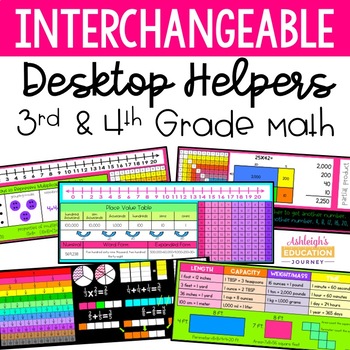Desk Name Tags - With a Math Twist
Ashleigh
54.7k Followers
Grade Levels
3rd - 4th, Homeschool
Subjects
Resource Type
Standards
CCSS3.MD.B.4
CCSS3.MD.C.5
CCSS3.MD.C.5a
CCSS3.MD.C.5b
CCSS3.MD.C.6
Formats Included
- PDF
Pages
10 pages
Ashleigh
54.7k Followers
What educators are saying
Great resources for my struggling Math students. They now have a resource to help them and they feel more independent.
This resource is what I've always wanted, but could never find until this year. I love how I can put an "anchor chart" on each students desk, so it is always visible if they need the help. I really like that there is a plate for each unit, so it isn't too cluttered.
Description
Give your students desk name plates or desktop helpers that are directly related to the topics you are teaching in math. These are 4x10.75 in size.
These are different from what already exists:
- I don’t add student names. We move around the classroom all of the time, so while students do have a desk, they don’t sit at it all day. Plus, everyone knows where everyone’s desk is, so I don’t need names on the tags.
- These desktop helpers are for math only.
- These cards are interchangeable. I do not use the same set of cards all year. I find that adding a year’s worth of content to a set of cards is overwhelming to students, so I focus on one unit at a time. Place self-adhesive pockets on students’ desks and easily swap out one card for another.
What's Included
- Card 1-Includes a number line for addition and subtraction. I’ve found that a number line is my #1 go-to tool for students who need help with addition and subtraction. I’ve also included a hundreds chart to help with rounding. Students can also reference a place value table through the hundred thousands place and see an example of numeral, written, and expanded form.
- Card 2-The number line from Card 1 remains on Card 2 for students who still need help with addition and subtraction. This card is what I use when I begin teaching multiplication and division. There is a colorful hundreds chart, as well as examples of different ways to represent multiplication.
- Card 3-The only difference between Card 3 and Card 2 is that is shows students how to represent division, rather than multiplication.
- Card 4-On this card, there is a multiplication table. There is also an example of a 2-digit by 2-digit area model for multiplication and a 3-digit by 1-digit multiplication problem solved with partial product. I’ve found that students often appreciate having these examples to refer to. The bottom of the card describes the difference between factors and multiples.
- Card 5-The difference between Card 4 and Card 5 is that Card 5 shows an example of division with an area model and division with partial quotient.
- Card 6-This card includes a colorful fraction table which helps students identify equivalent fractions, as well as compare fractions. There is also a visual model and equation that shows how to generate equivalent fractions. There is a model of adding and subtracting with like denominators and a multiplication problem where a whole number is multiplied by a fraction.
- Card 7-This card includes a measurement conversion table for length, capacity, mass, and time. There is also an illustration of Gallon Kingdom, which is my favorite way to teach gallons, pints, quarts, and cups. There is also a model and equation example for finding area and perimeter, with and without displaying square units.
- Card 8-Geometry-This card shows examples of different types of lines, including parallel and perpendicular lines. It also includes a quadrilateral flow chart.
Total Pages
10 pages
Answer Key
Does not apply
Teaching Duration
1 Year
Report this resource to TPT
Reported resources will be reviewed by our team. Report this resource to let us know if this resource violates TPT’s content guidelines.
Standards
to see state-specific standards (only available in the US).
CCSS3.MD.B.4
Generate measurement data by measuring lengths using rulers marked with halves and fourths of an inch. Show the data by making a line plot, where the horizontal scale is marked off in appropriate units-whole numbers, halves, or quarters.
CCSS3.MD.C.5
Recognize area as an attribute of plane figures and understand concepts of area measurement.
CCSS3.MD.C.5a
A square with side length 1 unit, called “a unit square,” is said to have “one square unit” of area, and can be used to measure area.
CCSS3.MD.C.5b
A plane figure which can be covered without gaps or overlaps by 𝘯 unit squares is said to have an area of 𝘯 square units.
CCSS3.MD.C.6
Measure areas by counting unit squares (square cm, square m, square in, square ft, and improvised units).





